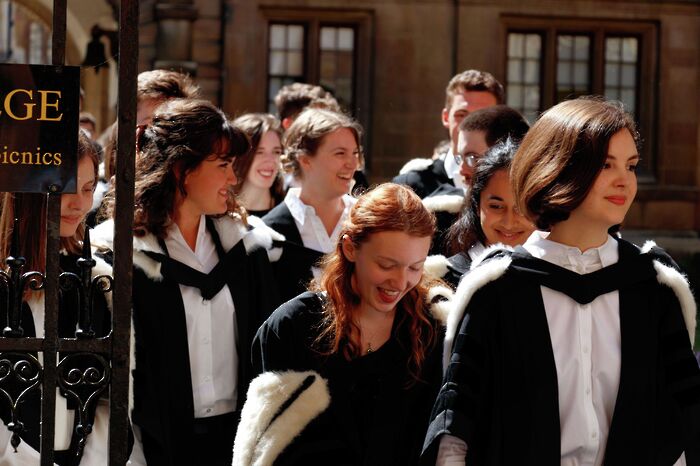Cambridge must take radical action to tackle gender inequality in maths
By any reasonable comparison to nationwide figures, or indeed to Oxford, Cambridge’s Maths Faculty is failing when it comes to gender equality

Criticism of the stark lack of women studying Maths at Cambridge often falls down by falsely rooting the issue in the view that Maths, and Science subjects in general, is somehow inherently superior to the Arts and Humanities. Having switched from Maths to Modern and Medieval Languages at the start of this academic year, I of course reject this. Value-judgements of many academic subjects are often rooted in deeply misogynistic attitudes, which equate ‘male-dominated’ with ‘rigorous and intellectual’, while dismissing subjects more traditionally associated with women as ‘soft’.
And so if, as some people argue, far fewer women were simply choosing to study Maths, favouring other subjects due to personal preference and enjoyment (although of course gendered stereotypes do exist and influence us all) then Cambridge’s shockingly low application rate, and even lower acceptance rate, of women in Maths would not be such a cause for concern.
But Cambridge’s admissions figures consistently reveal a significantly lower proportion of applications from women to study Maths than to similar universities, including Oxford. And, of these, despite roughly equal proportions of offer holders to applicants, a large drop is consistently seen in the proportion of women ultimately accepted to the course.
Gender disparities are not in themselves necessarily a symptom of anything sinister. But gender disparities which mark Cambridge Maths as starkly male-dominated in comparison with similar universities, and which consistently reveal a significantly smaller proportion of female students accepted than that of female students applying to the course, must be examined, and they must be challenged.
“We know that this University and this Faculty was not designed for us, but it must now be radically reworked to ensure that it is well-placed to appeal to, and cater for, all interested female mathematicians”
At 15%, the 2018 Cambridge Maths cohort has the second-lowest percentage of female students since 2002, when data first became available, and marks Maths as the most male-dominated Tripos in Cambridge.
At Oxford, women make up 28.5% of Maths undergraduates this year. To take another example, in the 2015-16 Admissions Cycle, the most recent year for which statistics are available on the University’s website, 29.1% of Durham’s Maths cohort were women.
You don’t need to study Maths to recognise that these percentages – both almost double Cambridge’s proportion of female maths undergraduates this year – throw the 15.0% figure into a rather shocking light.
According to an article published on the Institute for Fiscal Studies’ website in 2018, women made up 28% of students sitting Further Maths A Level that year (one of Cambridge’s prerequisites). This figure is roughly in line with the proportions of female students admitted to universities such as Oxford and Durham, but Cambridge’s Maths acceptance figure, again, falls far below.
For a Maths Faculty which prides itself on being among the best in the world, such a disproportionately low figure is both disappointing and alarming.
The faculty has a responsibility to adapt their admissions system to support and encourage prospective female students. We know that this University and this Faculty, the oldest Tripos in Cambridge, was not designed for us, but it must now be radically reworked to ensure that it is well-placed to appeal to, and cater for, all interested female mathematicians. Faced with these figures, major action, beyond simple presentations lauding the very few women already present in the Faculty, is necessary.
After all, how can you even claim to attract the “brightest and the best” students if admissions figures consistently reveal that the significantly higher numbers of the most qualified women are, in fact, choosing to apply to rival Universities?
Furthermore, even given disproportionately low application rates compared to similar universities, women nevertheless made up 23.8% of Cambridge Maths applicants last year, and 23.9% of offer holders, but ultimately only 15.0% of acceptances.
This is not an anomaly. Cambridge’s admissions statistics consistently reveal a drop in the proportion of offers made to female students, and the proportion of female students ultimately accepted, often explained as being due largely to STEP, the exams – taken alongside A Levels – which Cambridge requires as a condition of offers made to prospective students.
In the past, particularly when choosing to apply to Cambridge, I just accepted the suggestion that Cambridge is helpless to the fact that women apparently less frequently succeed in STEP, and thus the Faculty is not to blame for figures so shockingly low as 15%.
But women and men are equally capable of studying Maths – that’s not up for debate as far I’m concerned. And therefore these statistics must beg the question: if men are consistently outperforming women in your examinations, perhaps the fault lies with the examinations themselves, rather than those that take them?
If your Faculty consistently fails to appeal to prospective female applicants, and accepts even fewer, you must launch serious initiatives to identify and resolve the problems, not just for the benefit of future students, but for the women who are already here.
I don’t study Maths anymore – I didn’t enjoy it, and I wasn’t very good at it by Cambridge standards – but having spent a year in the subject, I can anecdotally confirm that women who study Maths at Cambridge are very well aware of how rare they are.
The Centre for Mathematical Sciences’ Core building is often crowded with supervisions, and with people chatting and studying. It’s honestly a lovely place to work. But I definitely noticed when I walked in and it seemed that the only women, out of many people in the large room, were myself, my supervisor, and the occasional receptionist.
Almost two years ago, when I first arrived in Cambridge to study Maths, I wrote an article investigating the huge gender disparity within my subject, and those I interviewed also highlighted STEP as a reason for Cambridge’s disproportionately low application rates, particularly in comparison with Oxford, which offers a different means of assessment: the MAT exam.
The key difference between the two exams is the time at which they are taken. The Oxford MAT exam is pre-interview, and therefore, as for most subjects, Oxford Maths offers consist only of A Level requirements. The Cambridge STEP exams, however, are taken alongside A Levels. This means that, having received an offer from either institution, students are more likely to ultimately be admitted to Oxford than to Cambridge, although overall application to acceptance rates remain largely the same.
It’s sometimes suggested that women are “less keen to take risks” than men, and thus, perhaps judging STEP to present a larger risk since it is taken post-offer, they are less willing to apply to Cambridge than to Oxford or another UK university. This may be true, but that doesn’t mean it isn’t Cambridge’s responsibility to change their system to respond to this phenomenon. Whether this fact, or something entirely different, is to blame for the Maths Faculty’s consistently disappointing admissions figures, It’s not enough to simply accept that a certain element of your application system, however innocently intended, doesn’t appeal to women, and argue that it is therefore their fault they don’t apply to your course. The responsibility to appeal equally to all prospective applicants must lie ultimately with the Faculty, not with any individual teenager considering potential universities.
Perhaps too many people – academics, students, admissions tutors – have told themselves so many times that women simply don’t apply to study maths at Cambridge that this has come to be accepted as a mere fact of life rather than a symptom of something deeply wrong.
I don’t doubt that the Maths faculty is looking seriously at gender equality, and I know that many talented female mathematicians at the University are working hard to promote women in the subject. However, it’s nevertheless clear that radical change is required if the balance of female students accepted, by any reasonable comparison to other similar UK universities, is to be redressed. If the Faculty’s current systems are failing to attract and support female students, then these systems must be rejected.
 News / Uni Scout and Guide Club affirms trans inclusion 12 December 2025
News / Uni Scout and Guide Club affirms trans inclusion 12 December 2025 News / Cambridge Vet School gets lifeline year to stay accredited28 November 2025
News / Cambridge Vet School gets lifeline year to stay accredited28 November 2025 News / Pembroke to convert listed office building into accom9 December 2025
News / Pembroke to convert listed office building into accom9 December 2025 Features / Searching for community in queer Cambridge10 December 2025
Features / Searching for community in queer Cambridge10 December 2025 News / Uni redundancy consultation ‘falls short of legal duties’, unions say6 December 2025
News / Uni redundancy consultation ‘falls short of legal duties’, unions say6 December 2025











